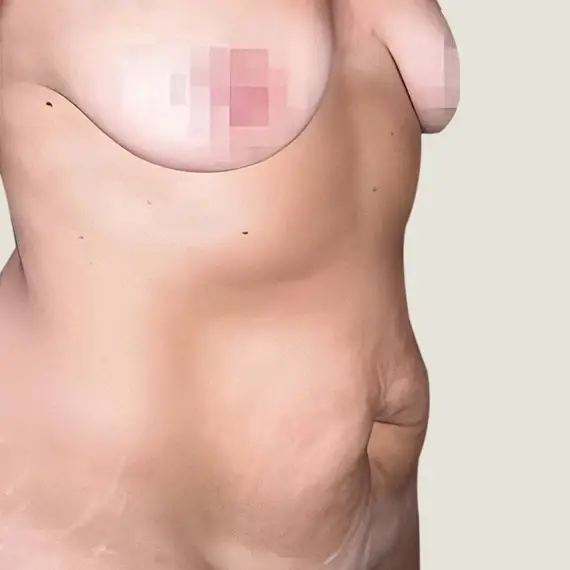Abdominoplasty: Tummy tuck
From 4995€
Surgery duration
3 hours
Anesthesia
General
Postoperative rest
24 hours
Recovery
1 month
Results
3-4 weeks
We are not a franchise
We have our own medical team
What is Abdominoplasty?
Abdominoplasty, commonly known as a tummy tuck, is a cosmetic surgery designed to remove excess skin and fat from the abdomen while tightening the abdominal muscles. It is a popular choice for individuals looking to enhance their abdominal appearance, particularly after significant weight loss or pregnancy.
How is an abdominoplasty procedure performed?
El proceso quirúrgico paso a paso
La abdominoplastia se realiza bajo anestesia general, y el tiempo de operación puede variar dependiendo del tipo de abdominoplastia que necesites:
- Incisión: El cirujano realiza una incisión horizontal en la parte inferior del abdomen, generalmente a nivel del pubis. La longitud de la incisión dependerá de la cantidad de piel que se va a remover.
- Eliminación del exceso de piel y grasa: Se elimina la piel sobrante y, si es necesario, el cirujano retira la grasa localizada.
- Reforzamiento de los músculos abdominales: Si los músculos abdominales están debilitados o separados, se suturan para mejorar la firmeza de la pared abdominal.
- Reposicionamiento de la piel: La piel restante se estira hacia abajo, se recorta el exceso y se sutura en su lugar.
- Colocación del ombligo: Si es necesario, el ombligo se recoloca en su nueva posición, acorde a la nueva forma del abdomen.
Before and after photos of abdominoplasty
Abdominoplasty


Abdominoplasty


Abdominoplasty


Who is a good candidate for Abdominoplasty?
An ideal candidate for abdominoplasty is someone who:
- Has excess skin or fat in the abdomen that cannot be eliminated with diet or exercise.
- Has undergone multiple pregnancies that have left the abdomen with loose skin.
- Has experienced significant weight loss and is left with excess loose skin.
- Is in good overall health and has realistic expectations about the surgery’s results.
- Does not plan future pregnancies, as they may reverse the results.
Preoperative tests for abdominoplasty
Prior to undergoing abdominoplasty, several preparations ensure a safe surgery:
- Medical Evaluation: A check-up to confirm overall health.
- Blood Tests: To detect any underlying health issues.
- Electrocardiogram: If necessary, to assess heart health.
- Anesthesia Consultation: To determine the best type of anesthesia for the procedure.

Postoperative care for abdominoplasty
To promote a smooth recovery after abdominoplasty surgery, follow these care instructions:
- Bandages and Drains: Bandages are applied to reduce swelling, and drains help remove excess fluids.
- Medications: Take prescribed pain relievers and antibiotics as directed.
- Rest: Take adequate rest and avoid strenuous physical activities for the first few weeks.
- Scar Care: Follow specific instructions for proper scar healing.
These steps are crucial for ensuring a safe and swift recovery.
Enhances body shape and appearance
Reduces the appearance of stretch marks
Improves posture
24-hour patient support
What is the Price of Abdominoplasty?
The cost of abdominoplasty can vary depending on factors such as the clinic, surgeon, and complexity of the case. Typically, the price ranges from 4995-7995€
Factors Affecting the Price of Abdominoplasty
- Complexity of the Procedure: If the surgery involves more extensive work, such as muscle repair or additional liposuction, the cost will be higher.
- Type of Abdominoplasty: The cost can differ based on whether a full tummy tuck or mini tummy tuck is performed, as this affects the area treated.
- Surgical Materials: Advanced materials like special sutures or mesh for muscle reinforcement can influence the price.
- Duration of Surgery: If the surgery takes longer due to the amount of tissue removed, the cost may increase.
- Postoperative Care: Post-surgery treatments such as compression garments, drains, and follow-up visits will add to the total cost.

Where Can I Have Abdominoplasty?
At Clínica EGOS, we offer abdominoplasty at various locations, making it easy for you to access the treatment in a convenient and nearby clinic.
Frequently asked questions about abdominoplasty
Can I exercise after an abdominoplasty?
During the three months following surgery, it is important to avoid physical effort, exercise, or sports. Avoid lifting weights, running, and aerobic routines. It is also not recommended to exert pressure when bending, pulling, or pushing during the 4 to 6 weeks of postoperative recovery. During follow-up visits, consult with your surgeon about when physical activity can be resumed.
Is abdominoplasty the same as liposuction?
This is a very common question among patients looking to reshape their bodies. The answer is no. It’s important to highlight that abdominoplasty is not the same as liposuction, although they are compatible procedures. In fact, many patients undergo both treatments to remove excess fat and abdominal flaccidity.
How should I prepare for abdominoplasty surgery?
Before surgery, there are several steps patients should follow to ensure the best results and improve the recovery process. At Clínica Egos, we recommend abdominoplasty patients refrain from smoking for the 3 weeks before and the 3 weeks after the procedure. It is also advisable to use a germicidal soap for body washing. In addition, the intake of medications like aspirin or other substances that may interfere with blood clotting should be discontinued.
Will there be scars after abdominoplasty?
Yes, abdominoplasty leaves a visible scar in the lower abdomen, similar to a C-section scar but usually longer. Over time, the scar fades and can be hidden with underwear or a swimsuit.
Does abdominoplasty completely remove abdominal fat?
Although abdominoplasty removes a significant amount of fat and skin, it’s important to maintain a healthy diet and exercise regularly to preserve long-term results.
Can I combine abdominoplasty with other procedures?
Yes, many people choose to combine abdominoplasty with liposuction or other cosmetic procedures such as a body lift or breast surgery for more comprehensive results.
How long does it take to recover from abdominoplasty?
Full recovery can take between 4 and 6 weeks. During this time, it is essential to avoid intense physical activity and follow the surgeon’s instructions closely.
What are the risk factors associated with abdominoplasty?
The risks associated with abdominoplasty include:
- Infection: As with any surgery, there is a risk of infection in the treated area, especially if postoperative instructions are not properly followed.
- Slow or abnormal healing: Some individuals may experience delayed healing or the formation of visible scars.
- Fluid accumulation (seromas): Fluid may collect under the skin, which might require drainage.
- Excessive bleeding: Bleeding can occur during or after surgery and may, in rare cases, require additional intervention.
- Loss of sensation: Temporary or permanent loss of sensation in the abdominal area can occur.
- Deep vein thrombosis: There is a low risk of developing blood clots, especially if the patient does not move adequately after surgery.
- Asymmetry: The abdomen may not be completely symmetrical after the procedure.
- Respiratory complications: Although rare, breathing difficulties may arise if abdominal pressure affects the lungs.
Will there be scars after abdominoplasty?
Yes, the main scar is located in the lower part of the abdomen and may extend from hip to hip. If the navel is repositioned, there will also be a small scar around it. Scars typically fade over time and can be treated with creams or laser.
Can I combine abdominoplasty with other procedures?
Yes, it is common to combine it with liposuction to enhance body contouring or as part of a Mommy Makeover.
Can I get pregnant after abdominoplasty?
Yes, but it is recommended to undergo the procedure once you are done having children, as pregnancy can affect the results.
Is it necessary to wear compression garments after surgery?
Yes, compression garments are essential to reduce swelling, improve healing, and help shape the abdomen. Typically, they should be worn for 4 to 8 weeks.
How long does it take for abdominal swelling to go down after surgery?
Swelling after abdominoplasty is completely normal and follows a gradual reduction process:
- First 2–3 weeks: This is when most of the swelling occurs, which will decrease with the use of a postoperative girdle and proper care.
- First 2–3 months: Swelling continues to gradually decrease and results become more visible.
- At 6 months: Most swelling has subsided and the contours of the abdomen are more defined.
- At 12 months: Final results are fully visible, with skin and tissues adapted to the abdomen’s new shape.
Recovery time varies depending on the patient, the type of abdominoplasty performed, and adherence to postoperative care.
Can abdominoplasty be done without surgery?
There is no 100% equivalent non-surgical alternative, as abdominoplasty removes excess skin and repairs abdominal muscles when they are weakened.

Related treatments for abdominoplasty
Our Abdominoplasty Team

Dr. Tiago Gomes
My main goal with abdominoplasty is to restore abdominal firmness that has been lost—whether due to the passage of time, pregnancy, or weight fluctuations. It’s not just about removing excess skin, but about regaining that sense of youth and self-confidence. Throughout my career, I’ve refined techniques that allow for natural results and the most comfortable recovery possible for my patients.
More information about Dr. Tiago Gomes
Dr. Santiago Elvira i Barberà
I understand that the abdominal area is crucial not only from an aesthetic perspective but also from a functional one. That’s why in every abdominoplasty, I focus both on correcting skin laxity and on strengthening the underlying muscles. This procedure represents an important step toward my patients’ confidence and comfort in their bodies, restoring harmony and proportion to their silhouette.
More information about Dr. Santiago Elvira i Barberà
Dra. Lorena Vives
Every body is unique, and that’s why abdominoplasty must be tailored to the specific needs of each patient. Throughout my career, I’ve specialized in advanced techniques that allow this surgery to be combined with other procedures, always aiming for harmonious results. What satisfies me the most is seeing how the physical transformation also brings about a positive emotional change in each patient.
More information about Dra. Lorena Vives
Dr. Holidey Cano
When my patients consult me about abdominoplasty, the first thing I explain is that this surgery is not only aesthetic — it also has an impact on their daily well-being. A firmer, flatter abdomen not only improves appearance but also supports better posture and mobility. It’s a process that aims to enhance both physical health and self-perception.
More information about Dr. Holidey Cano
Dr. Francisco Mora
One of the most important aspects of abdominoplasty is the careful planning of every detail. I make sure that each patient fully understands every step of the process, from preparation to recovery. For me, transparency and communication are essential so that every patient feels safe and confident throughout their transformation journey.
More information about Dr. Francisco Mora
Dr. Martín Gastón
Abdominoplasty is a great option for those looking to restore abdominal firmness after pregnancy or weight loss. Realistic expectations and good overall health are essential. We always recommend a personalized consultation.
More information about Dr. Martín GastónOur patients say about EGOS
Average rating: 4.9 / 5




